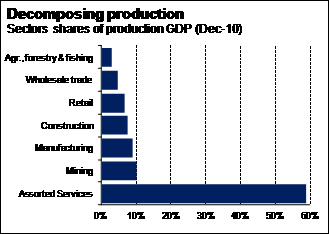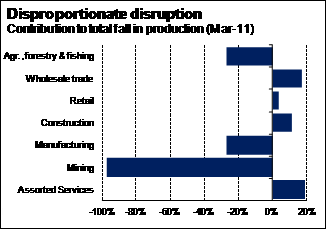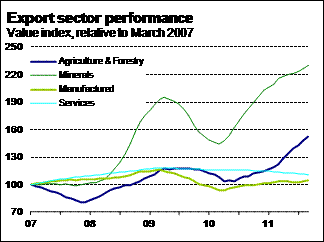What’s wrong with a two-speed?
Australia’s two-speed economy, a situation where exports are strong and domestic demand is weak, isn’t that bad. Buoyant exports are protecting Australia from many of the problems facing other developed nations.
Shrugging off the Global Financial Crisis
Australia’s 16-year run of strong growth, on the back of are sources boom, stalled when the Global Financial Crisis (GFC) intensified after the collapse of Lehman Brothers in August 2008. Commodity prices took a hit as financial market problems began to infect economies across the globe. Australia’s terms of trade fell sharply from a record high in September 2008 and by September 2009 was some 18% lower.
Export earnings began to suffer, and the government feared that Australia would follow the global economy into recession. Therefore, in late 2008 the government announced a stimulus package, comprising cash payments to households, designed to boost domestic demand. At a similar time the government extended guarantees to all bank deposits and wholesale bank funding to protect the domestic banking industry. In February 2009 a second, much larger, stimulus package was announced which included further cash payments, as well as support for infrastructure, schools, investment, and housing.
The stimulus packages, coupled with the Reserve Bank of Australia slashing its target interest rate to 3%, seemed to do the trick. Annealed growth bottomed out at 0.9%, and unlike the rest of the developed world, Australia did not enter a recession. Moving into 2010, the terms of trade began to bounce back, and by June 2010 it had surpassed its previous peak. This trend was helped by China, whose government also implemented a massive stimulus package, leading to a sharp increase in China’s demand for resources. Consequently, Australia’s trade surplus was a record A$16.2bn in the 2010calendar year.
The Queensland floods
On the back of booming export returns, economic growth climbed to 2.7%pa in the 2010 calendar year, compared with only 1.4%pa in 2009. However, the Queensland floods (December 2010 to January 2011) led to a temporary, but sharp, contraction to this trend. Real GDP fell 0.9% in the March 2011 quarter before recovering 1.2% the next quarter.
The vulnerability of the Australian economy to this extreme weather event highlights the economy’s dependence on production in a limited range of sectors for growth. Therefore it is interesting to consider the shares which each sector comprises of total production in the economy.

Graph 1
Graph 1 shows that the majority of production in the Australian economy stems from service-related industries. All other industries have individual shares of less than 10% of total output. However, when the Queensland floods hit, it was volatility in these smaller industries which contributed the most to Australia’s fall in output (see Graph 2).

Graph 2
The floods besieged an area about four times the size of New Zealand, swamping mines and crops. Therefore, with Queensland accounting or approximately half of global coking coal exports and 28% of Australia’s fruit and vegetable production, the disruption to the overall Australian economy was significant.
Most other industries continued to grow, as their activity is more evenly spread throughout Australia. The exception was manufacturing, with the competitiveness of firms in this industry eroded by the ongoing lift in the Australian dollar to post-float highs.
A "two speed" economy?
The common factor between the Queensland floods and the GFC is that they both disrupted Australia’s resources sector. The GFC negatively affected prices, while the floods hit production.
Although economic growth in between the two negative shocks was relatively strong, people have begun to worry that Australia’s economy relies too much on strength in the mineral resources sector, and that this strength only trickles slowly into other parts of the economy. Economists and journalists have called this situation a "two-speed" economy.

Graph 3
The two-speed economy is evident from Graph 3. Apart from a temporary blip in the March 2009 year, Australia’s mineral resource exports have soared. In contrast, agriculture and forestry, manufactured, and service exports (including tourism and education) have struggled for growth.
During this period the Reserve Bank of Australia faced the difficult task of setting monetary policy in response to the mining sector boom, without the economy overheating and causing inflation. As a result, during 2010 the RBA quickly unwound its emergency 3% cash rate. Over the 13 months to November 2010 the Bank raised interest rates to 4.75%.
Other sectors of the economy suffered as the Bank tried to contain this pressure from the mining sector. The Australian dollar was already high thanks to strong commodity prices, but rising interest rates added further upward pressure to the currency. The strong exchange rate squeezed the non-resource parts of the economy exposed to foreign competition – like food, manufactured goods, tourism, and education. Furthermore, higher interest rates dampened already weak consumer demand, and retailers continued to struggle for growth.
Moving into 2011 these pressures remained. Australia’s economy grew by 1.4% in the year to June 2011, down from 3.1% the year earlier.
The Queensland floods, the slow removal of government stimulus, and more recently an intensification of the European sovereign debt crisis further weighed on confidence within the Australian economy. Consumption growth has been slow, and businesses in most sectors have been reluctant to invest, particularly in new staff. Even though the mining sector has remained strong, mining accounts for less than 2% of total employment. Consequently employment has weakened.
Australia’s outlook
Australia’s economy will continue to be led by the mining sector thanks to strong demand from Asia and a high terms of trade. The hollowing out of manufacturing is unfortunate, but it is a necessary by-product of the mining boom. Australia’s comparative advantage lies with exporting raw materials to the developing world, not in the manufacturing of products from those resources.
The strong currency will continue to weigh on service exports, although the desirability of Australia as a tourist and education destination for newly wealthy Asians will offset this.
In contrast to strong growth in the mining sector, growth in domestic demand will remain weak for now. The savings ratio is currently at its highest level since the mid-1980s, offsetting the effect of strong income growth on spending activity over the last few years. Expect this trend to continue for now, especially as households worry about fallout from the European sovereign debt crisis. A slowdown in the Australian housing market is also negatively affecting consumption.
However, rather than being an indication of weakness in the economy, strong savings are a sign of potential future strength. Eventually households will become comfortable with their position and begin to loosen their purse strings. When this occurs, strong incomes will be translated into increased consumption growth (although not as rapid as the growth that was fuelled by debt before the GFC).
What if big brother catches a cold?
Lack of a clear and definitive resolution to the European sovereign debt crisis leaves risks to Australia’s outlook. As with New Zealand, these risks centre on three factors: trade, financial market conditions, and confidence.
The major risks for Australia’s exporters come not from direct trade prospects with Europe, but from the indirect effects of a European slowdown on Asia. A European slowdown will reduce demand for manufactured goods from Asia, potentially putting downward pressure on commodity prices.
If financial market conditions tighten, businesses in Australia (particularly those outside the mining sector) may have trouble financing investment. Volatility in credit default swaps for Australian banks (which capture the cost of insuring against the default of a loan) over recent weeks suggests this outcome is a distinct possibility.
The continued state of uncertainty may also weaken business and consumer confidence. Consumer spending is already lacklustre. However, a weakening of business confidence could lead firms to hold back on any plans to boost investment or employment.
A further slowdown in the Australian economy would have big implications for New Zealand. Not only were 23% of our exports sent to Australia over the last year, but as a commodity exporter we are exposed to the same risk channels as Australia. If Australia catches a cold, then so will we.








